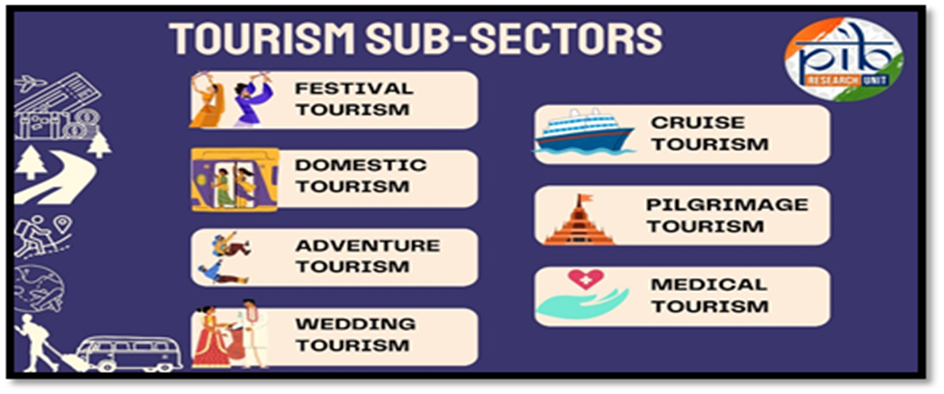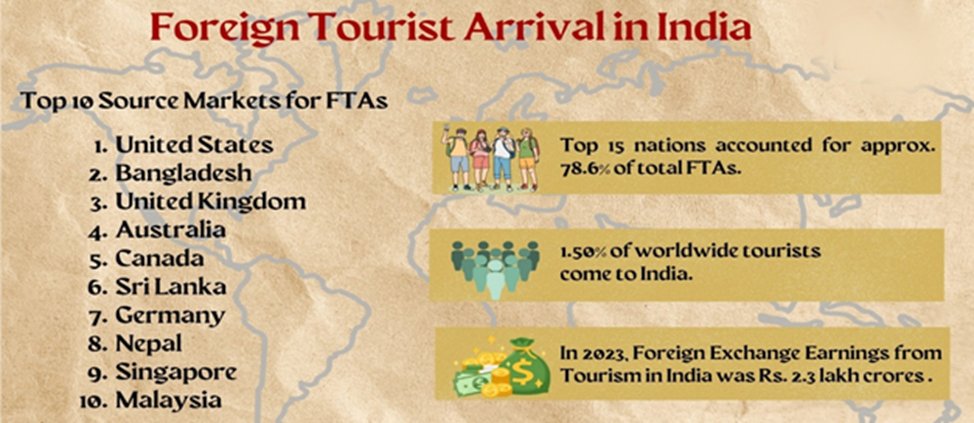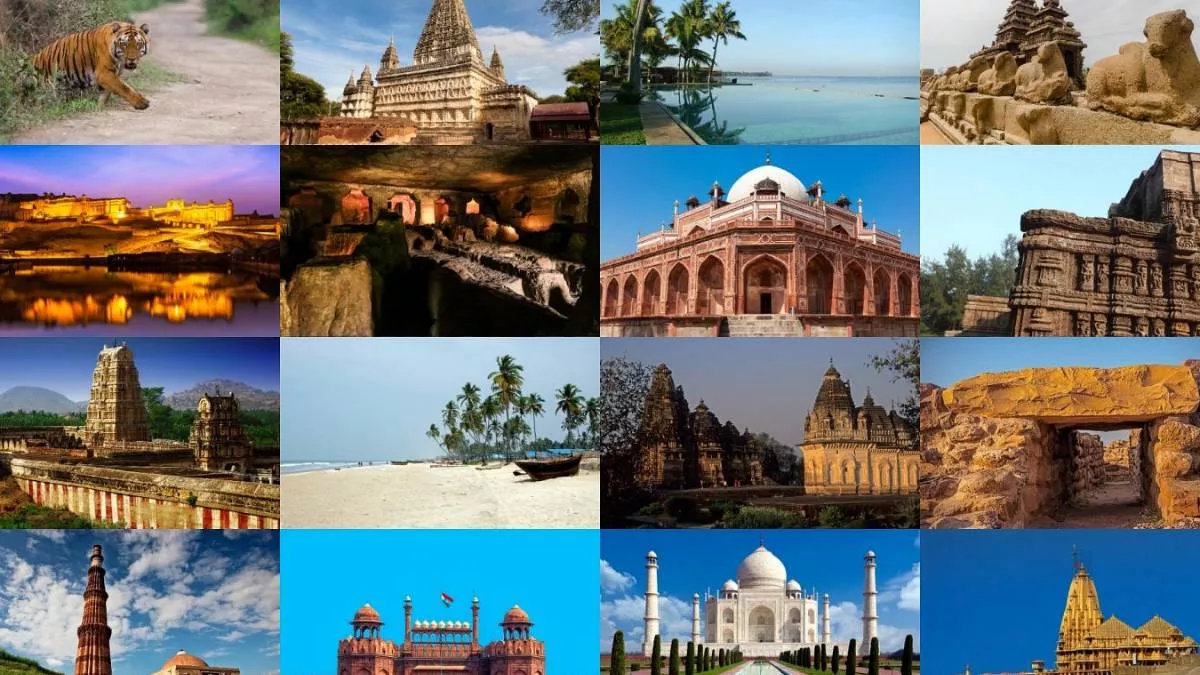Context:
India's tourism sector, with its rich heritage, cultural diversity and scenic destinations, is emerging as a global favorite. It plays a vital role in promoting economic growth, creating jobs, and enhancing the quality of life for millions of people. The Ministry of Tourism celebrated World Tourism Day on September 27, 2024, emphasizing tourism's role in promoting global peace through cross-cultural interactions. To make India a global travel destination, India has set an ambitious target of a USD 3 trillion tourism economy by 2047. Recognizing the potential of this sector, the Indian government has allocated ₹2,479 crore for tourism development in the financial year 2024-25.
|
The theme for World Tourism Day 2024, ‘Tourism and Peace,’ celebrated on 27 September, also highlights the vital connection between tourism and peace building. It emphasizes how travel, cultural exchange, and sustainable tourism practices can contribute to conflict resolution, reconciliation, and the promotion of global harmony. Key Initiatives Launched during World Tourism Day:
|
Key Initiatives Launched during World Tourism Day:
- Paryatan Mitra and Paryatan Didi: Piloted in six tourist destinations across India—Orchha (Madhya Pradesh), Gandikota (Andhra Pradesh), Bodh Gaya (Bihar), Aizawl (Mizoram), Jodhpur (Rajasthan), and Sri Vijaya Puram (Andaman & Nicobar Islands)—this program aims to improve tourists' experiences by introducing them to trained 'tourist-friendly' locals. The program emphasizes training women and youth to create innovative tourism products and experiences, such as heritage walks, food and craft tours, and homestays.
- Best Tourism Villages Competition 2024: This initiative recognizes villages preserving and promoting cultural and natural assets through community values and commitment to sustainability. This year, a total of 36 villages were recognized across eight categories from 991 applications submitted by 30 States and UTs.
- Incredible India Content Hub and Digital Portal: A revamped digital portal was launched to facilitate better access to information about tourism.
- Handbook for States/UTs: This handbook provides guidance for granting industry status to the tourism and hospitality sectors, streamlining processes for stakeholders.

Global perspective of Tourism in India:
According to the Travel and Tourism Development Index (TTDI) 2024, published by the World Economic Forum, there has been increasing trends in global tourism after the COVID-19 pandemic.
India ranks 39th among 119 countries in the TTDI 2024, reflecting improvements in three key areas:
- Prioritization of Travel & Tourism
- Safety & Security
- Health & Hygiene
The Government of India is working to transform the country into a top tourist destination by 2047, using tourism as a tool for social inclusion, employment generation, and economic progress.
46th UNESCO World Heritage Meeting: For the first time, India hosted this significant event from July 21 to July 31, 2024. Prime Minister Shri Narendra Modi inaugurated the session and announced a $1 million grant to support capacity building, technical assistance, and conservation efforts in Global South countries.
Foreign tourism in India:
- India witnessed a significant rise in foreign tourist arrivals (FTAs) in 2023. A total of 9.24 million foreign tourists visited India, marking a 43.5% growth compared to 6.44 million in 2022. This led to Foreign Exchange Earnings (FEEs) of Rs 2.3 lakh crores, a 65% increase from the previous year’s Rs 1.39 lakh crores.
- During the first half of 2024, 47.78 lakh foreign tourists visited India, contributing Rs. 1.27 crore in foreign exchange earnings. To further boost these numbers, the government has implemented several measures, including:
-
- Promotion of adventure and niche tourism
- Simplified e-visa availability
- Launch of a 24x7 multilingual helpline for tourists
- Promotion of adventure and niche tourism
-
- The ‘Paryatan Didi’ and ‘Paryatan Mitra’ program launched on World Tourism Day is aimed at creating a welcoming and memorable experience for tourists in India.

Rise in Domestic Tourism:
Domestic tourism is a crucial pillar of India's tourism growth. The government has launched initiatives such as:
- Dekho Apna Desh: Encourages domestic travel by promoting India’s rich heritage and lesser-known destinations through webinars and digital resources.
- PRASHAD (Pilgrimage Rejuvenation and Spiritual Augmentation Drive): Launched to integrate pilgrimage destinations sustainably, enhancing the religious tourism experience.
- Vibrant Village Programme: With a financial outlay of ₹4,800 crore, this program aims to develop 2,963 selected villages in Border States to enhance tourism and quality of life.
- Swadesh Darshan 2.0: Focused on developing tourism facilities, the revamped Swadesh Darshan 2.0 now identifies 57 destinations for sustainable and responsible tourism development including ‘Dholavira’ & ‘Dwarka’ in Gujarat, ‘Bundi (Keshoraipatan) & ‘Jodhpur’ in Rajasthan and ‘Sindhudurg’ & ‘Ajanta-Ellora (District Chhatrapati Sambhajinagar)’ in Maharashtra.
- Regional Connectivity Scheme – Udaan: This regional connectivity scheme has operationalized approximately 519 routes, enhancing accessibility to tourism hubs including 53 tourism & 48 helicopter routes.
These programs aim to raise awareness about tourist destinations and promote tourism-related activities across the country. As a result of these efforts, India recorded a remarkable 2509.63 million domestic tourist visits (DTVs) in 2023, up from 1731.01 million DTVs in 2022.
Employment Generation through Tourism:
- In 2022-23, tourism contributed significantly to job creation in India. A total of 76.17 million direct and indirect jobs were generated by the sector, compared to 70.04 million in 2021-22. The growth in tourism-related employment is expected to continue as infrastructure and connectivity improve.
- The potential of the sector extends beyond employment. As India gears up to bid for events like the Olympics 2036 and Youth Olympics 2029, scaling up training and infrastructure in tourism could align with larger national goals.
Infrastructure Development
India has invested $1 billion to build tourism infrastructure, improving facilities and enhancing the tourist experience. Improved infrastructure is key to attracting both domestic and foreign tourists, and the government's initiatives in this direction are helping India grow into a leading travel destination.
Conclusion:
India's tourism industry is on a promising trajectory, driven by the ambitious goal of achieving a USD 3 trillion tourism economy by 2047 under the Viksit Bharat@2047 initiative. Despite facing various challenges, the sector continues to flourish, supported by strategic initiatives that enhance infrastructure, promote sustainable practices, and enrich the overall visitor experience. With a strong commitment to overcoming obstacles and capitalizing on opportunities, India is well on its way to becoming a leading global travel destination.
Probable questions for UPSC mains examination:
Analyze the impact of cultural diversity and heritage on India's tourism sector, citing examples of successful cultural tourism initiatives.







